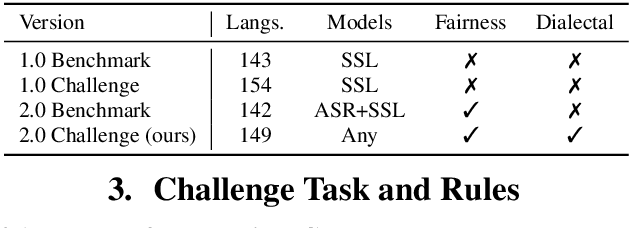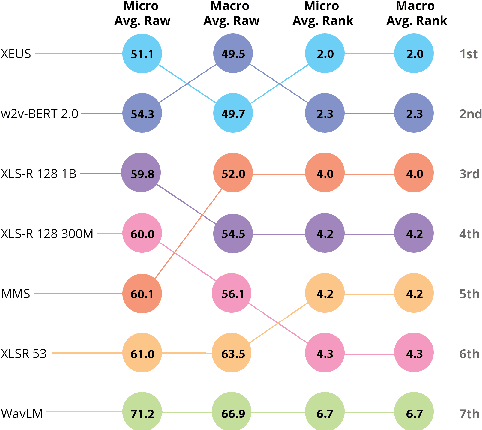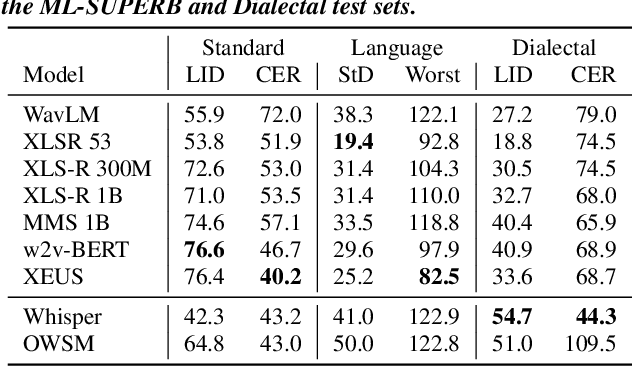Hung-yi Lee
Full-Duplex-Bench-v2: A Multi-Turn Evaluation Framework for Duplex Dialogue Systems with an Automated Examiner
Oct 09, 2025Abstract:While full-duplex speech agents enable natural, low-latency interaction by speaking and listening simultaneously, their consistency and task performance in multi-turn settings remain underexplored. We introduce Full-Duplex-Bench-v2 (FDB-v2), a streaming framework that integrates with an automated examiner that enforces staged goals under two pacing setups (Fast vs. Slow). FDB-v2 covers four task families: daily, correction, entity tracking, and safety. We report turn-taking fluency, multi-turn instruction following, and task-specific competence. The framework is extensible, supporting both commercial APIs and open source models. When we test full-duplex systems with FDB-v2, they often get confused when people talk at the same time, struggle to handle corrections smoothly, and sometimes lose track of who or what is being talked about. Through an open-sourced, standardized streaming protocol and a task set, FDB-v2 makes it easy to extend to new task families, allowing the community to tailor and accelerate evaluation of multi-turn full-duplex systems.
Pseudo2Real: Task Arithmetic for Pseudo-Label Correction in Automatic Speech Recognition
Oct 09, 2025Abstract:Robust ASR under domain shift is crucial because real-world systems encounter unseen accents and domains with limited labeled data. Although pseudo-labeling offers a practical workaround, it often introduces systematic, accent-specific errors that filtering fails to fix. We ask: How can we correct these recurring biases without target ground truth? We propose a simple parameter-space correction: in a source domain containing both real and pseudo-labeled data, two ASR models are fine-tuned from the same initialization, one on ground-truth labels and the other on pseudo-labels, and their weight difference forms a correction vector that captures pseudo-label biases. When applied to a pseudo-labeled target model, this vector enhances recognition, achieving up to a 35% relative Word Error Rate (WER) reduction on AfriSpeech-200 across ten African accents with the Whisper tiny model.
SHANKS: Simultaneous Hearing and Thinking for Spoken Language Models
Oct 08, 2025Abstract:Current large language models (LLMs) and spoken language models (SLMs) begin thinking and taking actions only after the user has finished their turn. This prevents the model from interacting during the user's turn and can lead to high response latency while it waits to think. Consequently, thinking after receiving the full input is not suitable for speech-to-speech interaction, where real-time, low-latency exchange is important. We address this by noting that humans naturally "think while listening." In this paper, we propose SHANKS, a general inference framework that enables SLMs to generate unspoken chain-of-thought reasoning while listening to the user input. SHANKS streams the input speech in fixed-duration chunks and, as soon as a chunk is received, generates unspoken reasoning based on all previous speech and reasoning, while the user continues speaking. SHANKS uses this unspoken reasoning to decide whether to interrupt the user and to make tool calls to complete the task. We demonstrate that SHANKS enhances real-time user-SLM interaction in two scenarios: (1) when the user is presenting a step-by-step solution to a math problem, SHANKS can listen, reason, and interrupt when the user makes a mistake, achieving 37.1% higher interruption accuracy than a baseline that interrupts without thinking; and (2) in a tool-augmented dialogue, SHANKS can complete 56.9% of the tool calls before the user finishes their turn. Overall, SHANKS moves toward models that keep thinking throughout the conversation, not only after a turn ends. Animated illustrations of Shanks can be found at https://d223302.github.io/SHANKS/
Hearing the Order: Investigating Selection Bias in Large Audio-Language Models
Oct 01, 2025Abstract:Large audio-language models (LALMs) are often used in tasks that involve reasoning over ordered options. An open question is whether their predictions are influenced by the order of answer choices, which would indicate a form of selection bias and undermine their reliability. In this paper, we identify and analyze this problem in LALMs. We demonstrate that no model is immune to this bias through extensive experiments on six LALMs across three widely used benchmarks and their spoken counterparts. Shuffling the order of answer options can cause performance fluctuations of up to 24% and even change model rankings, raising concerns about the reliability of current evaluation practices. We also study permutation-based strategies and show that they can mitigate bias in most cases. Our work represents the first systematic investigation of this issue in LALMs, and we hope it raises awareness and motivates further research in this direction.
When Silence Matters: The Impact of Irrelevant Audio on Text Reasoning in Large Audio-Language Models
Oct 01, 2025Abstract:Large audio-language models (LALMs) unify speech and text processing, but their robustness in noisy real-world settings remains underexplored. We investigate how irrelevant audio, such as silence, synthetic noise, and environmental sounds, affects text reasoning tasks where audio is unnecessary. Across three text-based benchmarks, we find that even non-informative audio reduces accuracy and increases prediction volatility; the severity of interference scales with longer durations, higher amplitudes, and elevated decoding temperatures. Silence, often assumed neutral, destabilizes outputs as strongly as synthetic noise. While larger models show greater resilience, vulnerabilities persist across all evaluated systems. We further test mitigation strategies and find that prompting shows limited effectiveness, whereas self-consistency improves stability at the cost of increased computation. Our results reveal cross-modal interference as a key robustness challenge and highlight the need for efficient fusion strategies that preserve reasoning performance in the presence of irrelevant inputs.
How Does Instrumental Music Help SingFake Detection?
Sep 18, 2025Abstract:Although many models exist to detect singing voice deepfakes (SingFake), how these models operate, particularly with instrumental accompaniment, is unclear. We investigate how instrumental music affects SingFake detection from two perspectives. To investigate the behavioral effect, we test different backbones, unpaired instrumental tracks, and frequency subbands. To analyze the representational effect, we probe how fine-tuning alters encoders' speech and music capabilities. Our results show that instrumental accompaniment acts mainly as data augmentation rather than providing intrinsic cues (e.g., rhythm or harmony). Furthermore, fine-tuning increases reliance on shallow speaker features while reducing sensitivity to content, paralinguistic, and semantic information. These insights clarify how models exploit vocal versus instrumental cues and can inform the design of more interpretable and robust SingFake detection systems.
Do You Hear What I Mean? Quantifying the Instruction-Perception Gap in Instruction-Guided Expressive Text-To-Speech Systems
Sep 18, 2025Abstract:Instruction-guided text-to-speech (ITTS) enables users to control speech generation through natural language prompts, offering a more intuitive interface than traditional TTS. However, the alignment between user style instructions and listener perception remains largely unexplored. This work first presents a perceptual analysis of ITTS controllability across two expressive dimensions (adverbs of degree and graded emotion intensity) and collects human ratings on speaker age and word-level emphasis attributes. To comprehensively reveal the instruction-perception gap, we provide a data collection with large-scale human evaluations, named Expressive VOice Control (E-VOC) corpus. Furthermore, we reveal that (1) gpt-4o-mini-tts is the most reliable ITTS model with great alignment between instruction and generated utterances across acoustic dimensions. (2) The 5 analyzed ITTS systems tend to generate Adult voices even when the instructions ask to use child or Elderly voices. (3) Fine-grained control remains a major challenge, indicating that most ITTS systems have substantial room for improvement in interpreting slightly different attribute instructions.
The ML-SUPERB 2.0 Challenge: Towards Inclusive ASR Benchmarking for All Language Varieties
Sep 08, 2025



Abstract:Recent improvements in multilingual ASR have not been equally distributed across languages and language varieties. To advance state-of-the-art (SOTA) ASR models, we present the Interspeech 2025 ML-SUPERB 2.0 Challenge. We construct a new test suite that consists of data from 200+ languages, accents, and dialects to evaluate SOTA multilingual speech models. The challenge also introduces an online evaluation server based on DynaBench, allowing for flexibility in model design and architecture for participants. The challenge received 5 submissions from 3 teams, all of which outperformed our baselines. The best-performing submission achieved an absolute improvement in LID accuracy of 23% and a reduction in CER of 18% when compared to the best baseline on a general multilingual test set. On accented and dialectal data, the best submission obtained 30.2% lower CER and 15.7% higher LID accuracy, showing the importance of community challenges in making speech technologies more inclusive.
DeSTA2.5-Audio: Toward General-Purpose Large Audio Language Model with Self-Generated Cross-Modal Alignment
Jul 03, 2025Abstract:We introduce DeSTA2.5-Audio, a general-purpose Large Audio Language Model (LALM) designed for robust auditory perception and instruction-following, without requiring task-specific audio instruction-tuning. Recent LALMs typically augment Large Language Models (LLMs) with auditory capabilities by training on large-scale, manually curated or LLM-synthesized audio-instruction datasets. However, these approaches have often suffered from the catastrophic forgetting of the LLM's original language abilities. To address this, we revisit the data construction pipeline and propose DeSTA, a self-generated cross-modal alignment strategy in which the backbone LLM generates its own training targets. This approach preserves the LLM's native language proficiency while establishing effective audio-text alignment, thereby enabling zero-shot generalization without task-specific tuning. Using DeSTA, we construct DeSTA-AQA5M, a large-scale, task-agnostic dataset containing 5 million training samples derived from 7,000 hours of audio spanning 50 diverse datasets, including speech, environmental sounds, and music. DeSTA2.5-Audio achieves state-of-the-art or competitive performance across a wide range of audio-language benchmarks, including Dynamic-SUPERB, MMAU, SAKURA, Speech-IFEval, and VoiceBench. Comprehensive comparative studies demonstrate that our self-generated strategy outperforms widely adopted data construction and training strategies in both auditory perception and instruction-following capabilities. Our findings underscore the importance of carefully designed data construction in LALM development and offer practical insights for building robust, general-purpose LALMs.
An Exploration of Mamba for Speech Self-Supervised Models
Jun 14, 2025



Abstract:While Mamba has demonstrated strong performance in language modeling, its potential as a speech self-supervised (SSL) model remains underexplored, with prior studies limited to isolated tasks. To address this, we explore Mamba-based HuBERT models as alternatives to Transformer-based SSL architectures. Leveraging the linear-time Selective State Space, these models enable fine-tuning on long-context ASR with significantly lower compute. Moreover, they show superior performance when fine-tuned for streaming ASR. Beyond fine-tuning, these models show competitive performance on SUPERB probing benchmarks, particularly in causal settings. Our analysis shows that they yield higher-quality quantized representations and capture speaker-related features more distinctly than Transformer-based models. These findings highlight Mamba-based SSL as a promising and complementary direction for long-sequence modeling, real-time speech modeling, and speech unit extraction.
 Add to Chrome
Add to Chrome Add to Firefox
Add to Firefox Add to Edge
Add to Edge